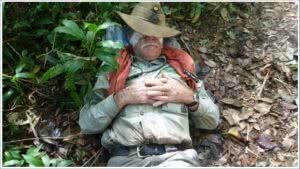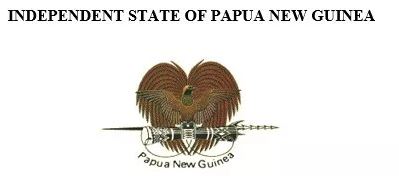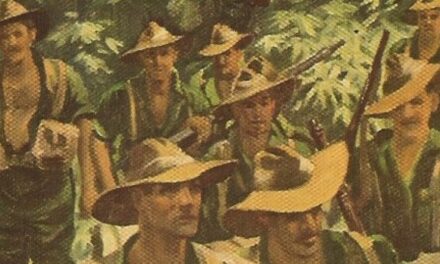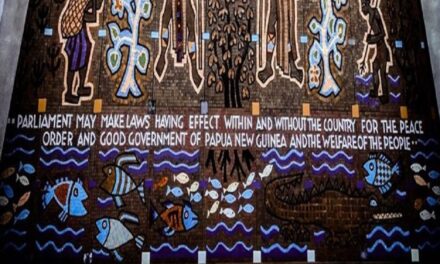KOKODA TRAIL KEY FACTS
OUR VISION FOR THE KOKODA TRAIL:
‘The Kokoda Trail to realize its potential as a high-value, world-class pilgrimage tourism destination for the economic beneift of traditional village communities who own the land sacred to our shared military heritage.‘
DFAT
Prior to the 50th anniversary of the Kokoda campaign in 1992 tourists rarely trekked across the Kokoda Trail.
There were no trek fees – villagers earned no income.
An Anzac trek which I led on the 50th anniversary of the Kokoda campaign reawakened Australia’s interest and generated some rare positive publicity for Papua New Guinea which was virtually a ‘no-go’ zone for tourists due to serious law and order issues at the time.
Over the next few years our Kokoda treks featured positive stories in every major television and media network throughout Australia – this led to a surge of interest in trekking across the Trail.
Subsistence villagers across the Kokoda Trail earned zero income from pilgrimage tourism until the 50th anniversary of the Kokoda campaign in 1992.
Since then the Trail has emerged as PNGs most popular tourism destination with more than 65,000 Australians having trekked across it. The has generated an estimated K75 million in earnings for village communities.
Our anecdotal research with the 7,000+ Australians we have led indicates they were motivated by the military history of the Kokoda campaign and the physical challenge it presented.
They never expected to have a ‘cultural awakening’ or an ‘environmental levitation’ – they simply wanted to walk in the footsteps of our diggers, hear their stories, and experience some of the adversity they had to overcome to stop a fanatical enemy on our doorstop in 1942.
Their cultural awakening with our closest neighbour, former territory and wartime ally comes later.
After the war the men who fought in the campaign returned to their cities and towns to rebuild their lives. Few had any desire to return to the battlefields and revisit the trauma they experienced. For many it took an Anzac Day reunion to get them to even talk about it among their mates.
But their stories slowly seeped out as baby boomers lined their Anzac Day marches and later perched on tank-stands outside mechanics halls around the country to eavesdrop on their stories.
Kokoda Tourism
Interest in Kokoda tourism lay dormant for 50 years before I led my first group across it in 1942 – prior to this small groups of hardy adventures periodically ventured across it but there were no economic benefits or opportunities for villagers, and no interest from Canberra.
The publicity generated from our first group to commemorate the 50th anniversary of the Kokoda campaign led to an increase in public interest and to more inquiries.
After leading more groups and learning more about the Trail and its people I submitted a proposal for a Master Plan to develop the Kokoda Trail as a National Memorial Park in good faith in 1994 – it was ignored.
In 1996 I led a group of celebrities across the Trail for a Channel 9 Anzac Day special – the group included Angry Anderson, Daryl Brathwaite, Dermot Brereton, Collette Mann and Grant Kenney.
The screening of the program on ‘A Current Affair’ resulted in the highest ratings ever achieved by the show. It reinforced my view that Australians want to know more about our wartime history and led to an increase in awareness of the pilgrimage.
More trekkers inevitably led to a desire from subsistence villagers to share in the economic benefits from foreign trekkers crossing their traditional land. Their frustrations were ignored by government and eventually led to local disputes and trek closures.
PNG Management: 1992-2008
We believed their concerns were valid as the result of the relationship we established with them over the previous 12 years and proposed a management body be established to cope with the emerging interest in Kokoda tourism.
Our proposal was accepted by the PNG Minister for Provincial and Local Level Government Affairs, Sir Peter Barter, who established a Kokoda Track (Special Purpose) Authority (KTA). However he advised it would have to be self-funded as the PNG economy was not in good shape at the time.
Our company, Adventure Kokoda, provided the initial funding for the new KTA with an advance of $10,000 to allow it to sustain its office until trek fees could be collected.
Department of Veterans Affairs (DVA) officials were difficult to engage and had no interest in assisting PNG to develop it as a National Memorial Park as we had proposed, and no interest in assisting them to manage it.
However, to their credit they did fund the construction of a significant memorial on the Isurava battlesite which we had rediscovered six years earlier 1996. The memorial was officially opened by Prime Ministers’ John Howard and Sir Michael Somare on the 60th anniversary of the battle in 2002.
Unfortunately DVA saw it is the end of their commitment to the Kokoda Trail while we hoped it would be the beginning as the number of trekkers increased by 423% from 1074 in 2003 to 5621 in 2008.
Mt Bini Goldmine
The discovery of an $4 billion (K10 billion) gold and copper deposit on Mt Bini adjacent to the Kokoda Trail in 2006 finally triggered Canberra to take an interest in it.
Frontier Resources claimed the economic benefits from the mine would provide more in taxes and royalties to the Papua New Guinea government than all Australian aid and provided the example of the expected royalties and taxes from Ok Tedi in 2007/08 (Media Release, 19 November 2007).
Newspaper reports estimated the return for landowners and the Kokoda Track Authority over the estimated 10-year production of the mine would be in the vicinity of $100 million (K234 million) with half quarantined for the preservation of the Trail and half for education for communities across the Trail.
Frontier Resources approval for the mine was successfully challenged on a technicality by both governments. Nauro landowners reportedly received a generous compensation package from the PNG Government and have since mostly abandoned their village and moved to Port Moresby.
Canberra’s intervention was therefore seen to have ‘saved’ the Kokoda Trail and they set about assisting PNG to obtain a World Heritage listing.
The Canberra Takeover – 2009
Canberra then committed $16 million (K38 million) to assist PNG to secure a world heritage listing via a ‘Joint Understanding between PNG and Australia on the Kokoda Track and
Owen Stanley Ranges’ signed in 2008. A major justification for the joint agreement was the need to protect the upper reaches of the Brown River as a potential water source for Port Moresby.
A year later the PNG government announced plans for a Chinese funded $260 million (K640 million) 54 MW Edevu Hydro Power Project on the Brown River which effectively negated the need for a World Heritage listing to protect of the water catchment in the swampland area between Nauro and Menari villages on the Trail.
However the announcement did not deter Canberra from dispatching bureaucrats and consultant environmentalists, anthropologists, archaeologists, academics, and social engineers intent on assisting PNG to establish a case for a World Heritage listing for the Owen Stanley Ranges which included the gazetted boundaries of the Kokoda Trail.
The invasion of new arrivals was reminiscent of Keith Wiley’s observations in ‘Assignment New Guinea’ in 1965:
‘In recent years the academics have discovered New Guinea. Grave, plump, portentous, they swarm north in their hundreds each winter, generally finishing somewhere near Goroka in the Eastern Highlands where at times they become so numerous that every bush and stone seems to conceal a lurking bureaucrat or anthropologist. After a few weeks or a few months they return home to prepare brisk solutions for all the problems which beset the land. Too often they see New Guinea coldly as an exercise in nation-building to be carried out as quickly as possible, with one eye on the taxpayer at home and the other on some ranting demagogue in the United Nations.
‘At times the maligned colonialists, who walked ever the country and fought for it, seem to come nearer the heart of the matter. Stripped of slogans and self- interest, New Guinea emerges not as a ‘problem’; to be ‘solved’, or assessed , but simply as a land, wild and beautiful, worthy to be loved for its own sake; with a people, backward, kindly, and in need of help[i].
The new arrivals from Canberra’s Department of Environment, Water, Heritage, and the Arts (DEWHA) were just as unfamiliar with PNG and the Melanesian Way as their predecessors were in 1965.
Rather than join a legitimate Kokoda tour company to experience the pilgrimage with fellow Australian taxpayers, to understand its historic significance and get a feel for the needs and expectations of local villagers they invariably opted to trek in their own small groups (at Australian taxpayers’ expense) with a local guide who knew nothing about military strategy, jungle warfare tactics, or the battles across the Trail.
Some returned to Canberra as ‘experts’ while others were assigned to a ‘Kokoda Development Program’ within the Australian High Commission to work on AusAID projects unrelated to pilgrimage tourism.
Others were later embedded within the PNG Conservation Environment Protection Authority (CEPA) in their quest to seek a World Heritage listing to prevent any further mining or logging incursions into the area. The fact that this would restrict economic opportunities for subsistence villagers was not an issue to the new wave of environmental zealots.
Both AusAID funded groups operated in isolation to each other and in a parallel universe to the reality of the ‘law of the jungle’ that prevailed across the Trail due to the lack of any form of management systems or control.
Neither Canberra officials nor the new DEWHA arrivals displayed any awareness of the findings of an earlier 2006 ‘Rapid Assessment and Prioritisation of Protected Area Management’ (RAPPAM) report for PNG. The comprehensive report had been compiled by the Department of Environment and Conservation, the PNG Forestry Authority, the Research and Conservation Foundation, the Nature Conservancy, and the Village Development Trust which concluded:
‘Many of the areas withhigh socio-economic importance are facing a relatively low degree of threat (Kokoda,Wiad, Pirung).
‘Areas like Lihir, Tonda, and Bagiai are exceptions to this rule and hence require more efforts to protect them from the variety of threats they are currently facing.’
Another group of DEWHA officials were assigned to the offices of the PNG KTA and assumed responsibility for the management of the Kokoda Trail. None had any previous experience in commercial business management, pilgrimage tourism, or the reality of the ‘Melanesian Way’. None had trekked across the Trail, so they had no understanding of its environment, its historic sites, or the adequacy of campsite facilities.
They also failed to conduct any village-based workshops to seek to understand local community needs and expectations – a fundamental necessity in ‘seeking to understand before being understood’ in Melanesian culture.
Their agenda was first exposed in their subtle redefinition of the ‘Kokoda Trail’ as a ‘Kokoda Corridor’ which included Sirinumu Dam in the south of Central Province to the northern beachheads of Oro Province, and a large portion of the Owen Stanley Ranges as part of a wider environmental agenda.
Rather than define their role as an ‘Owen Stanley Ranges Initiative’ they chose the term ‘Kokoda’ due to its emotive resonance with Australian taxpayers – it also firewalled them from any criticism of their wider socio-environment agenda.
The extended focus provided an alibi for Canberra to disregard the need for management systems to be introduced for the emerging Kokoda tourism industry.
As a result no management systems have ever been introduced; no investment has been directed toward the identification, protection and interpretation of military heritage sites to enhance the value of the pilgrimage for trekkers; no investment has been directed towards ensuring campsites are adequate to meet the needs of trekkers; no initiatives have been introduced to assist subsistence village communities to earn additional income by providing goods and services to meet the needs of trekkers; and there is no evidence of any plan to interpret the environment with discreet signage.
The results of their failure to properly manage Kokoda tourism since they took control in 2009 are a matter of record.
Kokoda trekker numbers have fallen by 46 percent which has resulted in a cumulative loss of some $19 million (K45 million) in foregone wages, campsite fees, and local purchases for the subsistence village communities across the Trail.
The failure can be attributed to Canberra’s emphasis on managing the Trail as an environmental bureaucracy to support a World Heritage listing instead of supporting a commercial tourism enterprise for the economic benefit of subsistence village communities across it.
Fallacy of World Heritage
In 2014 Canberra amalgamated the AusAID Kokoda Development Program with the DFAT Kokoda Initiative within the PNG Conservation Environment Protection Authority (CEPA).
The amalgamation coincided with an expert report by Dr Peter Hitchcock, Dr Jennifer Gabriel, and Dr Matthew Leavesley which found the Kokoda Trail did not meet the criteria for a World Heritage listing. The report effectively exposed thefallacy of their World Heritage project.
DFAT environment officials then scrambled to refocus their strategy towards the next level down by seeking ‘protected area (PA)’ status’ for an ‘Interim Protection Zone (IPZ)’ and sought to maintain their control over it via a clandestine attempt to establish a new environmental ‘Kokoda Track Management Authority’ within CEPA.
Once again, Canberra officials failed to consult with the two key stakeholders in the drafting process, i.e., Kokoda tour operators who generate the income for Kokoda tourism, and subsistence villagers who own the land sacred to our shared military heritage.
They also continued to ignore the findings of the 2006 ‘Rapid Assessment and Prioritisation of Protected Area Management’ report which should have seen them divert their environmental resources to areas that have already been identified as high-risk threats further afield in PNG.
[i] Assignment New Guinea. Keith Wiley. Jacaranda Press.1965 P. i
In 1996 I rediscovered the battlesite of Isurava which led to the opening of a major memorial by Prime Ministers’ Sir Michael Somare and John Howard on the 60th anniversary of the Kokoda campaign. It was the first memorial to be erected anywhere along the Trail since the end of the war in 1945.
Publicity generated by our Adventure Kokoda treks in the 1990s led to a 423% increase in trekker numbers from 1074 to 5621 – and the creation of a Kokoda trekking industry which has generated more than A$250 million (PNGK600 million) in tourism revenue since then.
In 2002 we lobbied for the establishment of a trek fee to be introduced to ensure villagers along the Trail received shared benefits from the emerging trekking industry.
The publicity generated by our Adventure Kokoda treks in the 1990s led to a 423% increase in trekker numbers from 1074 to 5621 – and the creation of a Kokoda trekking industry which has generated more than A$250 million (PNGK600 million) in tourism revenue since then.
In 2003 Adventure Kokoda, advanced K25,000 to establish a management authority for the Kokoda Trail due to a lack of support from both Governments at the time.
In 2004 the Minister for Provincial and Local Government esyablished Kokoda Track (Special Purpose) Authority KTA under the auspices of his Department.
In 2008 Canberra assumed responsibility for the management of the Kokoda Trail and assigned responsiblity for it to the Dept of Environment, Water, Heritage, and the Arts (DEWHA). The primary purpose was to assist PNG in obtaining a World Heritage lisiting for the Kokoda Trail and surrounding Owen Stanley Ranges and to protect the Brown River catchment area as a potential water source for Port Moresby.
The wartime heritage of the Kokoda Trail hardly rated a mention and the Minister for Veterans Affairs was effectivly sidelined along with the PNGs Minister for Tourism, Arts and Culture in PNG.
As a result, Australian environment officials were embedded in the PNG Conservation and Environment Protection Authority (CEPA) which has seen the Kokoda Trail managed as an evvironment park rather than as a tourism enterprise.
Soon after DEWHA was rebadged as the Dept of Sustainability, Environment, Water,
In 2015 a World Heritage review reported that the Kokoda Trail did not meet the requirements for a World Heritage listing:
DSEWPC was later rebadged as the Department of Climate Change, Energy, the Environment and Water (DCCEEW).
As a result of DEWHA/DSEWPC/DCCEEW manageing the Kokoda Trail as an environment park Trekker numbers have since plummeted by 42% from 5621 to 3237 which equates to a cumulative loss of some $20 million (K50 million) in foregone wages, campsite fees and local purchases for villager communities across the Trail.
In 2015 Major Charlie Lynn was inducted as an Officer of Logohu in the PNG New Year’s Honours and Awards list ‘for service to the bilateral relations between Papua New Guinea and Australia and especially in the development of the Kokoda Trail and its honoured place in the history of both nations’ over the past 25 years’.
According to TripAdvisor the Kokoda Trail is Papua New Guinea’s most popular tourism destination.
https://www.tripadvisor.com.au/Attractions-g294115-Activities-Papua_New_Guinea.html
In 2005 the Australian Financial Review assessed the Kokoda Trail as the No.1 trekking destination in the World.
In 2008 the Australian Government changed its focus from tourism to environment when they assumed responsibility for the Trail – the wartime significance of the trek experience has been significantly devalued since then.
The 10 Greatest Treks in the World
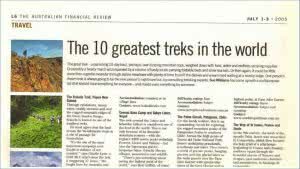
These facts beg the question: Why is the Kokoda Trail managed as an environment park for the benefit of foreign aid-funded officials, anthropologists, archaelogists and consultants rather than as a tourism enterprise for the economic benenit of traditional landowner communities?
Transition from Tourism to Environment
When Charlie Lynn led his first group across the Trail in 1992, they were escorted by armed police with serious shotguns from Owers Corner to Bomana War Cemetery because of the crime situation. As they passed buildings surrounded by razor wire, trekkers, who had felt safe in the jungle during the previous week, were now feeling insecure and intimidated.
The group was accompanied by a reporter from The Bulletin with Newsweek magazine after much hassling to obtain a visa for her. Port Moresby was regarded as one of the World’s most dangerous cities at the time and only ever received negative publicity – they were therefore suspicious of any reporters wanting to visit their country.
They need not have worried. The trek which coincided with the 50th anniversary of the Kokoda campaign was such a profound experience it featured as a positive cover story that led to a rekindling of our national interest in the significance of the word ‘Kokoda’ which had almost slipped from our collective memory.
Australians continued to be wary of travelling to PNG however as curfews were imposed in Port Moresby. Each night convoys of trucks rumbled into the CBD to deploy armed guards with savage dogs around razor wire barricades surrounding most buildings. Settlements on the fringes were strictly no-go areas.
But those who ventured beyond the razor wire into remote villages in the Owen Stanley Ranges discovered a different world. Strangers were welcomed as friends and presented with floral garlands by curious villagers. Children gathered and sang as elders watched on proudly from the base of their huts. In the evenings, a procession of women would arrive at campsites with freshly cooked vegetables and warm smiles. Trekkers knew they were in a safe place under the watchful eyes of their guides and carriers.
These experiences, repeated over the next 7-8 days, had a profound impact on our early trek groups. Most were unable to find words that would do justice to their feelings. Marion Frith captured the essence of the experience in a feature article for the Canberra Times in November 1992:
‘It is as if we have arrived. Somewhere, anywhere. Our guides sit with us, their families join us, and the village and its people become imprinted in our hearts. Another woman and I join the evening church service and are entranced as the pastor, his face illuminated by a hurricane lamp, recites the prayers in pidgin and the children’s voices rise in harmony so sweet we never want it to end.
‘We are silent as we get up from the rough-hewn pew. At that moment we have experienced life at its most perfect, superb in its simplicity, and suddenly we realise that the walk was worth it, if only to find this. Peace and joy are tangible, if fleeting, qualities and we know that where we are going to, where we have come from, we will probably never find it again. We want to seal the village in barbed wire and never let the world touch it.’
Until then the Trail had been a dormant jungle shrine for more than 50 years since the end of the War in the Pacific.
In the early 1990s our groups were challenged by a lack of local services and facilities in PNG and along the Trail. Campsites were often carved out of the jungle where groups decided to call it quits for the day. Everything required for the trek had to be imported as there were no trekking provisions in Port Moresby. Sections of the original Trail had to be reconnoitred and cleared with machetes.
The Trail itself was rugged, remote and pristine. The people were humble and hospitable. Stories of mateship, courage, and sacrifice were haunting and inspirational. Public reactions to television documentaries and newspaper stories indicated a high level of interest in Australian tourists from all walks of life wanting to retrace the footsteps of our diggers.
Papua New Guinea’s reputation as a ‘land of the unexpected’ combined with the aura of the Kokoda Trail stirred an inherent call for adventure that resides within many people.
Kokoda soon emerged as the fashionable ‘new black’ in adventure travel and now shares equal status with the World’s most esoteric destinations – Mt Everest, Mt Kilimanjaro, Machu Picchu, the Amazon and the Milford Track.
A change in emphasis from tourism to environment after the Australian Government assumed responsibility for the Trail in 2009 resulted in a failure to appreciate the fact that adventure tourists do not seek to have an ‘environmental levitation’ or a ‘cultural awakening’ when they commit to a trek across the Trail. They commit because they want to walk in the footsteps of our diggers ‘as they did it’ in 1942!
Whilst the combination of environment and culture provide an unforgettable bonus they are not the reasons tourists commit to a trek across the Kokoda Trail. No amount of environmental propaganda will change this fact.
The change in emphasis from tourism to environment resulted in a colonial management system with some $200 million (K500 million) being diverted towards aid projects and environment officials and consultants via the DFAT funded ‘Kokoda Initiative’ rather than providing adequate campsite facilities; establishing memorials at significant battle-sites; providing information on village clans and lifestyles; or the identification of flora, fauna, creeks and major features.
No training or micro-finance initiatives have been introduced to assist villagers to value-add to the experience by providing goods and services to meet the needs of trekkers – local subsistence villagers are now mere spectators to a passing parade of strangers.
‘Neo-Colonial’ Management System
Neither the former CEO of the KTA nor the current Acting CEO recruited via the Kokoda Initiative had any previous business/tourism management qualifications or experience. They have therefore been reliant on the ‘advice’ of various DFAT-Kokoda Initiative officials employed by the London based Oxford Policy Management consultancy embedded in their office.
This is reminiscent of a ‘Neo-Colonial’ system of management control which has been imposed on the KTA via the DFAT-Kokoda Initiative and CEPA.
The outcomes indicate it has not worked as there is not a single management protocol in place for the Kokoda Trail; not a single kina has been invested to meet the needs of trekkers through the development of significant battle-sites or campsites; and nobody has any idea where the K12 million they have collected in trek fees over the years has gone because they have never produced a financial statement or Annual Report.
Covid-19 exposed the fallacy of the current situation. Australian officials were evacuated to the safety of their homes in Australia and the security of generous salaries while villagers along the trail had to revert to subsistence living as no provision was made for their welfare by the DFAT-Kokoda Initiative, CEPA or the KTA – despite an investment of more than A$50 million (PNGK125 million) in aid funding over the past decade.
The suspension of trekking provided a timely opportunity for Papua New Guinea to reclaim ownership of their most popular tourism asset and reset its policy directions accordingly however nothing happened.
Papua New Guinea policymakers should be guided by the fact that the environment across the Trail has been successfully managed by generations of subsistence villagers – income generated from wartime tourism now offers them an opportunity to rise above their aid-funded subsistence lifestyles and provide for a sustainable economic future based on our shared wartime heritage.
Summary:
KOKODA TOURISM VALUE FOR PNG:
Some 65,000 Australians have trekked across the Kokoda Trail over the past 21 years – many of their stories have featured in national, state and local media outlets. The marketing value of ‘Kokoda stories’ for PNG Tourism during this period equates to tens of millions of dollars and has led to it being rated as the most popular tourism destination in Papua New Guinea. The trekking industry has generated more than A$350 million (K900 million) in tourism revenue since it emerged in the mid-1990s.
KOKODA ENVIRONMENT VALUE FOR PNG:
The topic of ‘environment’ along the Kokoda Trail has not generated any media interest or any income for local villagers – the only known articles are academic studies and the only beneficiaries are Australian officials from the Department of Climate Change, Energy, the Environment and Water (DCCEEW) and their consultants – a recent expert report advised that the Kokoda Trail does not meet the criteria for World Heritage.
PNG POSITIVE PUBLICITY:
PNG was reported to be on the verge of a ‘failed state’ due to rampant crime and corruption in the 1990s – this resulted in negative international publicity which acted as a major impediment to tourism.
Kokoda helped change this perception as the treks organised and led by Adventure Kokoda featured on every every major media outlet and led to tens of millions of dollars worth of positive publicity for PNG in general and the Kokoda Trail in particular.
The Kokoda Trail has since emerged as PNG most popular tourism destination as a result.
Following are links to the publicity generated by Adventure Kokoda:
National Television Programs
- Angry Anderson Kokoda Challenge Special
- Dareing Kokoda
- Sydney Swans on Kokoda
- Adventure Kokoda | ‘Getaway’ on Kokoda
- Rabaul
- Kokoda Mateship Trek 2009 – Scott Morrison MP and Jason Clare MP
- Walking with Legends
- Kokoda: In the Footsteps of the Brave
- Kokoda Mud Sweat and Tears – Channel 7’s Witness Program
- Cronulla to Kokoda ABC Compass Program
- Kokoda: Father Chris Riley’s Kids on Track
Natioinal Newspaper & Magazine Articles
Corporate Captains Shun Kokoda Trail
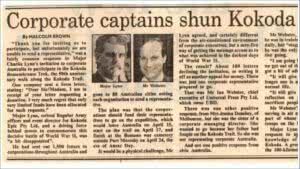
Following the Kokoda Footsteps
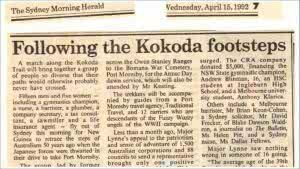
Bulletin with Newsweek Magazine
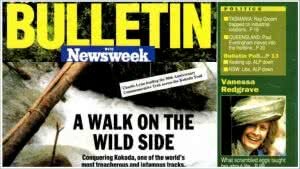
Herald Sun TV Extra To Hell and Back

Australian Geographic Magazine
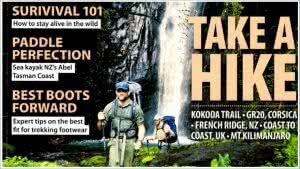
Airlines PNG Magazine King of Kokoda
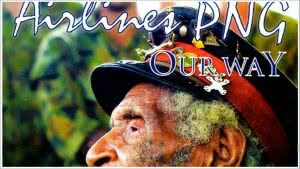
GWP Magazine Charlie Lynn Kokoda Trail
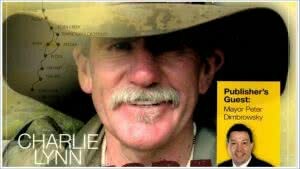
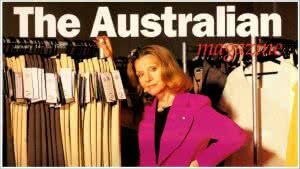

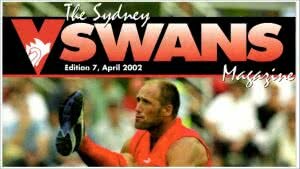

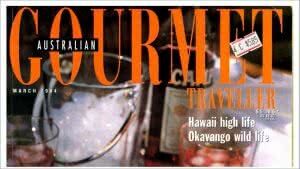
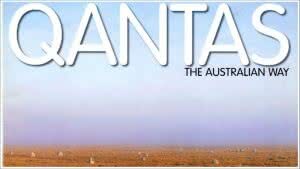

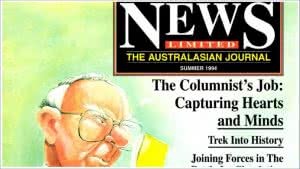
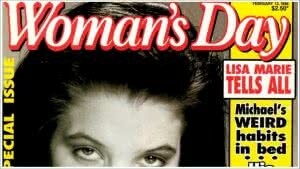

Australian Geographic Magazine
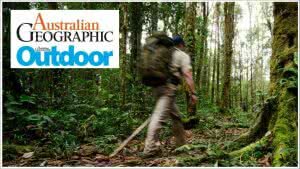
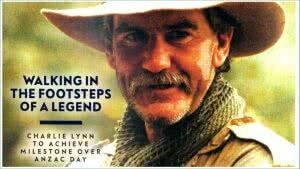
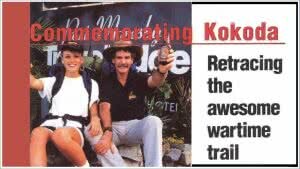
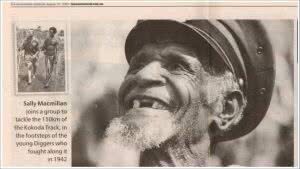
Aussies Salute Kokoda Track Heroes Who Fell


Kokoda Trekkers Mark Diggers Wartime Struggle
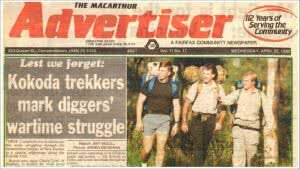

Defence Bulletin Adventure on the Kokoda Track
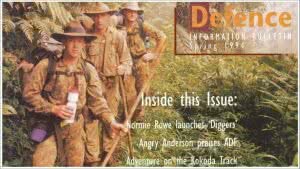
Kokoda Fall Tests Fuzzy Wuzzy Tales
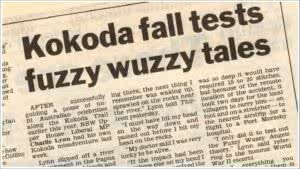

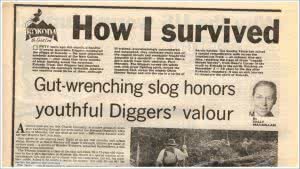
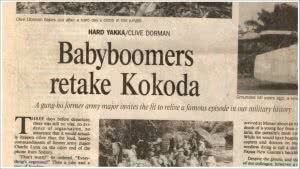
Is this the World’s Meanest Tour Guide
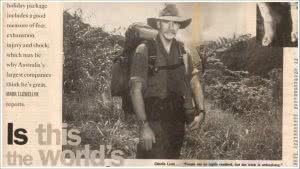
Hard Trek to the Corporate Top

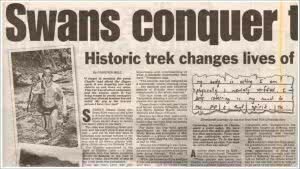

The Unforgettable Adventure of Kokoda

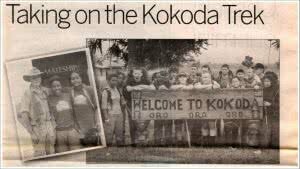
Managers Learn Teamwork by Reliving Kokoda Battle
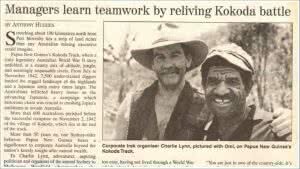
Kokoda Track Victory Against Logging
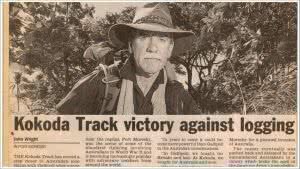
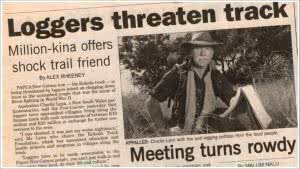

Flag Burner on the Kokoda Track



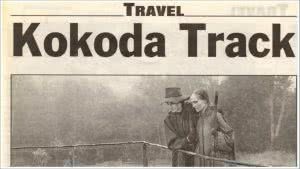
Kokoda Kids Learn Law of the Jungle
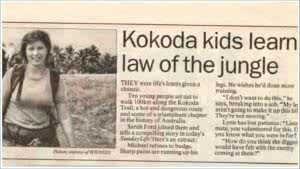

Honouring Sacrifices on the Kokoda Trail
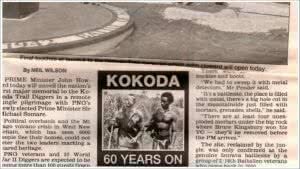
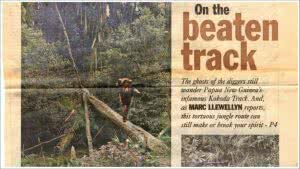
Fear and Loathing on the Punishing Kokoda Track


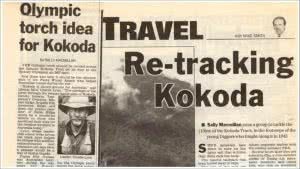
On The Trail of the Fighting Spirit of Australia
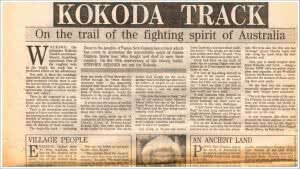

Honour at Last to Kokoda Diggers
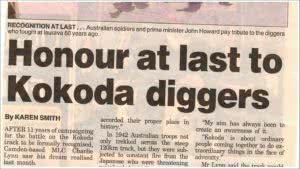

Ex-serviceman has Troops Battle-ready

A Patient’s Story by Peter Fitzsimons
